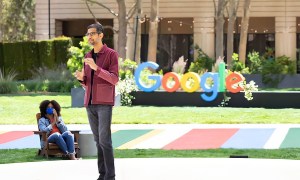
These days, it’s an unusual week when a new exploit, virus, or botnet isn’t uncovered, and that is increasingly true on mobile devices. To combat the growing problem, Google is rolling out Google Play Protect, a new security platform that brings transparency to Android’s anti-malware protections.
One component of Google Play Protect is a new antivirus hub that shows which apps have been scanned for malware. Verify Apps, the feature on Android Phones that protects against malware, exploits, and other viruses in real time, shows which apps have been recently scanned in a carousel menu, and when the most recent scan was completed. This feature was recently enabled — so you can head to the “Updates” section of Google Play to check it out now. On top of that, you’ll see a new Protect menu item in the Google Play Store, from which you can do things like see a list of recently scanned apps or disable devices scanning.

Another is Find My Device, a rebrand of Google’s location-tracking Android Device Manager.
The new Find My Device app, just like Android Device Manager before it, lets you easily locate, lock, and erase an Android device associated with your Google account. That same support extends to smartwatches powered by Android Wear.
Find My Device puts your devices front and center. Once you sign in with your Google credentials, you will see your phones, smartwatches, and tablets represented by icons at the top, which replace the old app’s drop-down menu. Tapping a device pulls up options to sound an audible alarm, lock it, or factory reset it. You will also see its current Wi-Fi status and battery life, as well as its rough geographic location on a Google Maps screen.
If your device doesn’t have a lock screen, Find My Device lets you enter a password you can use to unlock it when you find it. Alternatively, you can add a message or phone number where a good Samaritan can reach you if they find it.
The overhaul is long overdue. Google launched Android Device Manager in 2013, shortly after that year’s I/O conference, as an answer to Apple’s Find My iPhone service. Before then, managing an Android phone remotely required downloading and installing a third-party solution.
Google Play Protect is the latest in Google’s wide-ranging effort to improve Android security.
The search giant has worked with 351 wireless carriers to improve the time it takes to test security patches before deploying them to users, an effort that has resulted in a reduction of the software approval process from between six and nine weeks to just one week. It has doled out $1 million to independent security researchers, an amount that’s on track to reach $2 million next year. And it has pursued an aggressive strategy of encryption — as of December, 80 percent of Android 7.x (Nougat) users use encryption.
Adrian Ludwig, director of Android security at Google, sees social engineering — attacks that fool a user into installing an app that compromises his or her device’s security — as one of the biggest challenges facing app developers today. “People don’t want to think about security,” he told members of the press at the RSA conference in February. “They just want it to be that way.”
Update: Some consumer-facing Google Play Protect features in Google Play Store now rolling out.





